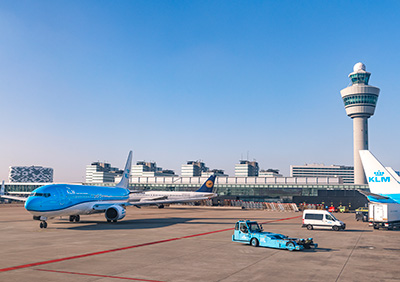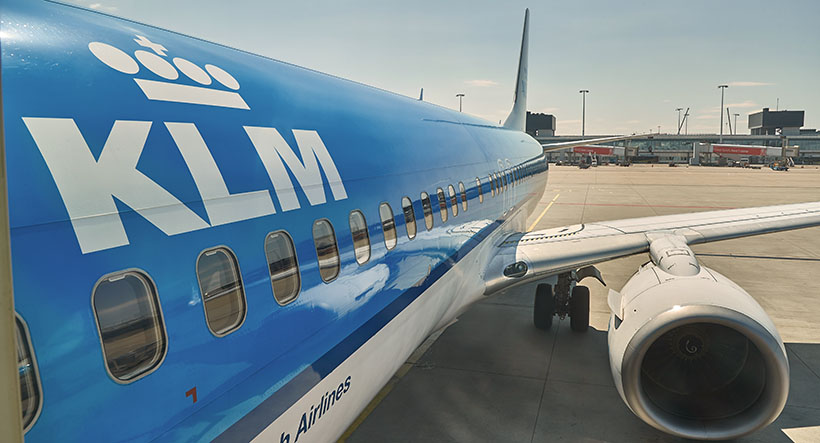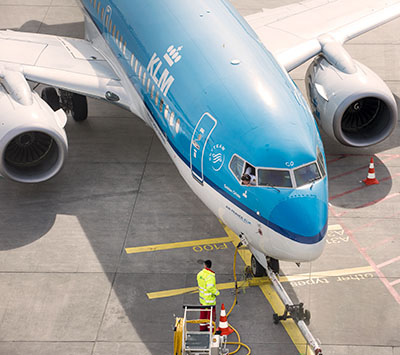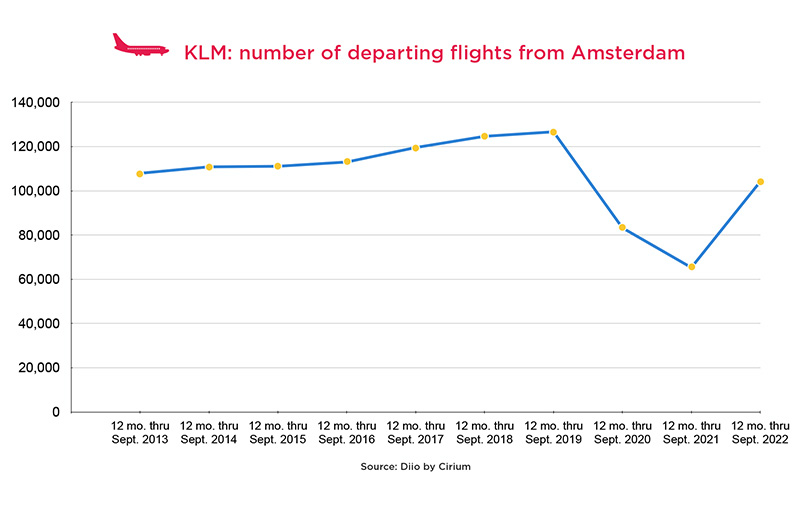
How KLM is leveraging its network to overcome industry challenges
By Mike Malik, Chief Marketing Officer at Cirium
It wasn’t an easy summer for KLM. The Dutch carrier suffered severe operational distress at its home airport Amsterdam, which responded by sharply limiting the total number of daily passengers using the airport.
With airport understaffing still a concern this fall, flight caps have remained in place in October. While air traffic is usually quieter in the fall than in the summer, Schiphol Airport have highlighted potentially higher traffic levels during the autumn holidays, as well as greater demands on security staffing from fall travelers wearing heavier clothing who will take longer to screen. Business travel is also recovering across the industry this fall.
| Despite these airport frustrations, which began this spring, KLM produced strong profits in the April-June quarter. |

In fact, if KLM were an independent airline, its 9.4% second quarter operating margin would have been best among all publicly listed European carriers, even Ryanair. KLM’s sister airline Air France only earned a 3.3% operating margin for the quarter. Transavia, the Air France/KLM group’s low-cost airline, lost money.
Several factors explain KLM’s strong financial results, including robust cargo demand, savings from fuel hedges, aggressive cost cutting, and recent efforts to simplify and modernize its fleet.
| In one respect, Schiphol’s airport capacity restrictions have been helpful, limiting supply amid surging demand, causing fares and load factors to jump. |
KLM filled 86% of its seats in the second quarter. It would rather, of course, have been able to accommodate the additional demand and not have to cancel so many flights. The situation, however, wasn’t all bad from a strictly financial perspective.
| Another important reason for KLM’s strong profits is its impressive flight network, viewable up close through the lens of Cirium’s portfolio of data tools. |
Amsterdam is one of the world’s leading hubs for flight connections, well-positioned to handle many intercontinental journeys. This distinction is proving even more valuable at a time when many nonstop routes have been cut or downsized.

Amsterdam’s utility as a global gateway is clear from KLM’s globe-spanning network of flights. For a deeper look, industry planners can turn to Diio by Cirium. Covering over 99% of worldwide airline schedules going back 20 years and looking forward 11 months, Diio provides complete end-to-end schedule and route planning.
In this case, Diio shows the island of Curacao to be KLM’s busiest route from Amsterdam, ranked by available seat kilometers (ASKs). Aruba, Bonaire, St. Maarten, and Suriname are other major routes, underscoring the importance of former and present Dutch territories in the Caribbean. KLM’s service to Indonesia and South Africa likewise has roots in Dutch imperial history.

Even more critical to KLM’s network is its portfolio of routes to North America. This includes service to 13 US airports, namely New York JFK, Los Angeles, San Francisco, Miami, Atlanta, Houston, Chicago, Washington, Las Vegas, Minneapolis, Salt Lake City, Boston, and Austin, the latter a new addition to the network since the pandemic. KLM serves five cities in Canada, another market it can connect—via Amsterdam, of course—to Europe, India, Africa, the Middle East, and elsewhere.
It can do the same for Latin America where it serves 12 markets, according to Diio’s Schedule Monthly Summary report for the 12 months to October. KLM flies to nine airports in Africa and seven in the Middle East. That’s in addition to a large East Asia network currently featuring 11 cities.
One area where KLM has less market clout is India. There it flies to just three cities: Delhi, Mumbai, and Bengaluru. Air France adds Chennai to the offering, but that’s still a few short of what British Airways or the Lufthansa Group can provide. Of Europe’s Big Three, only British Airways flies to Australia, leaving Gulf carriers in a better position to capture intercontinental demand in and out of that market.
| Those shortcomings notwithstanding, KLM’s Amsterdam hub remains a leading global gateway, fortified by KLM’s alliances with carriers like Delta, Gol, and Kenya Airways. |
Operating a dual hub system with Paris-based Air France provides a major boost as well—only London Heathrow has more monthly KLM seats from Amsterdam than Paris De Gaulle. Assuming China’s international market normalizes, KLM will have several close partners, led by China Southern and China Eastern.

The Dutch government will reduce and cap the total flight movements at Schiphol next November, in this case to cut noise and carbon emissions. It’s also raising aviation taxes, which could further threaten Amsterdam’s role as a premier connecting gateway. A smaller airport, Lelystad, might provide some relief for short-haul point-to-point flying, but not until later this decade if ever.
KLM could develop into more of a point-to-point carrier, handling fewer connecting travelers. How to navigate that transition will be a top challenge for the new CEO Marjan Rintel. She takes over for longtime chief Pieter Elbers who’s now running India’s IndiGo. Elbers presided over KLM’s strongly profitable growth and development. Can Rintel find new ways to succeed with a home hub that’s inhibiting growth?



























































